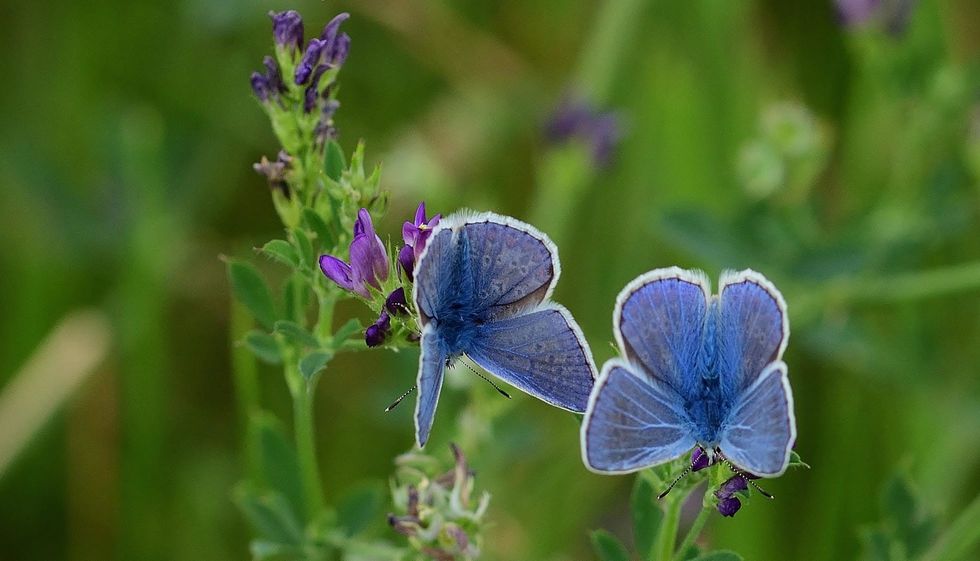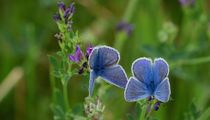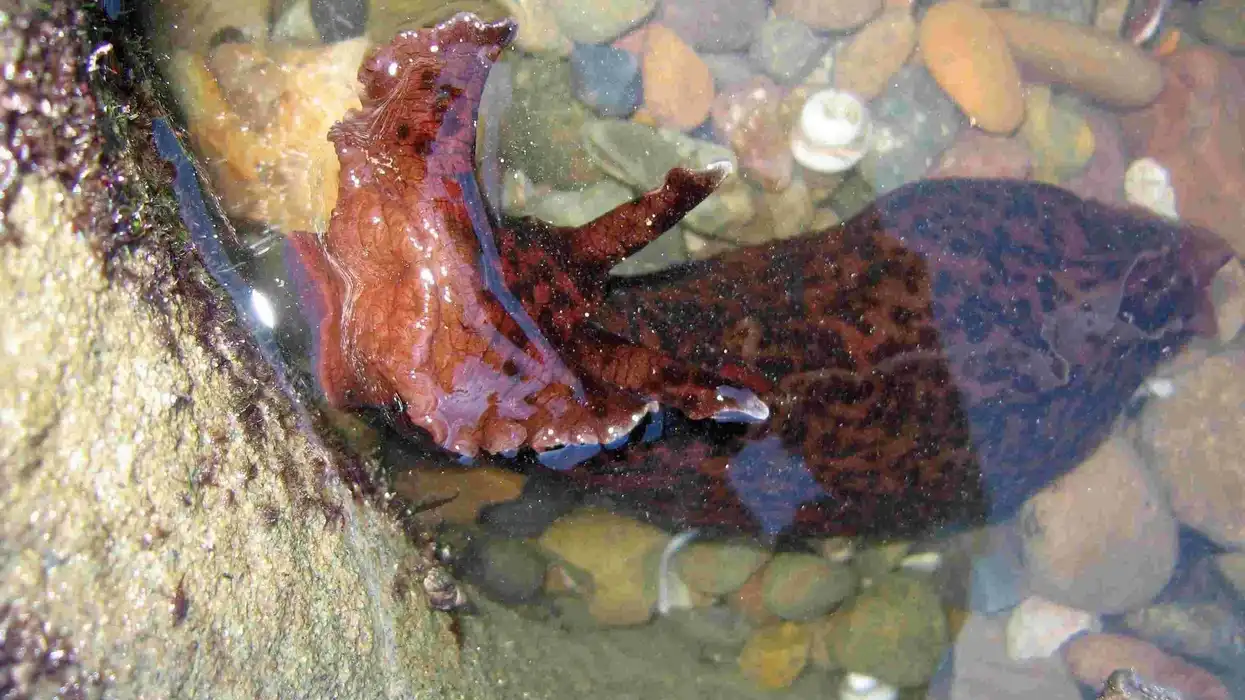Belonging to the order of Lepidoptera, the beautiful Palos verdes blue butterfly, Glaucopsyche lygdamus palosverdesensis is one of the rarest species of butterflies in the world.
After the decline of the endangered Palos verdes blue butterfly in California, it was found again in 1994 by Mattoni R. They are protected by federal law and a few captive rearing projects and reintroduction projects have been initiated by the government.
A lot of members are being protected at the Chandler preserve.
These insects do not live long, their adult lifespan is only about 4-5 days long, and it lasts between January and early March.
They prefer scrublands and rocky coasts as their habitat as their host plant only grow on rocky soil and they do not stray far from it. Please read on to learn more interesting facts about Palos Verdes blue butterfly habitat, or Palos verdes blue butterfly basic info.
For more relatable content, check out these red admiral butterfly facts and painted lady butterfly facts for kids.
Palos Verdes Blue Butterfly Interesting Facts
What type of animal is a Palos Verdes blue butterfly?
They are a species of butterflies endemic to Palos verdes peninsula in Los Angeles city. These gray-blue butterflies were assumed to be extinct in 1983 but later were rediscovered by biologist Rudi Mattoni in 1994 in San Pedro which is a community located in the northern part of the Palos Verdes county in Los Angeles.
What class of animal does a Palos Verdes blue butterfly belong to?
The Palos Verdes blue butterfly, Glaucopsyche lygdamus palosverdesensis are insects. They are thought to be one of the rarest species of butterflies found in the world because they are endemic to their very small range of habitat.
They are also very sensitive to habitat loss which is why their population has suffered a lot due to the destruction of said critical habitat.
How many Palos Verdes blue butterflies are there in the world?
The Palos Verdes butterfly was declared extinct but was later found again in 1994 by Rudi Mattoni, R Rogers, and Timothy Dahlum in San Pedro. As of now, the population happens to be measured at a mere 300 members, and decreasing because of habitat destruction.
Where does a Palos Verdes blue butterfly live?
They are native to the scrub areas of the coastal city of San Pedro, in Palos Verdes peninsula in Los Angeles, California. Recovery of the population of the endangered species after the 1987 decline in the northern part of the county is on the way with the captive rearing program and the reintroduction project.
What is a Palos Verdes blue butterfly's habitat?
They are found in a fog-covered, coastal city in Los Angeles. The host plants of the larvae, locoweed grows on sandy or gravelly soil, which is found in coastal areas and rocky slopes, which is why they are found in these areas.
Other than that they are also found on scrublands and weed shrubs. They were rediscovered in 1994 after they were assumed to be extinct in 1983 by biologist Mattoni R.
Who do Palos Verdes blue butterflies live with?
This gray-bluish butterfly is known for mostly being solitary throughout its short lifespan. They only interact with other members of their own kind during the breeding season. They are very attached to their home range in Los Angeles and do not stray far from it.
How long does a Palos Verdes blue butterfly live?
The lifespan of the adults of Palos Verdes butterfly is only five days, and the larvae spend 7-8 days in their pupae stage.
How do they reproduce?
After being discovered in the 1970s, entomologists were known to use only var lonchus solely as the host plant for the larvae during the captive breeding project. However, since then a report of females in the wild laying eggs on deerweed (lotus scoparius) plants as well with the var lonchus has been found.
The breeding period as well as the caterpillars entering the pupae stage goes on from January- early March. The adults also emerge during this January-March period. The eggs hatch after 7-10 days.
The caterpillars then eat from the host plant until they reach the pupae stage. After emerging from the cocoon adults only live for about 4-5 days.
What is their conservation status?
After being discovered in the 1970s, the Palos Verdes blue butterfly, Glaucopsyche lygdamus palosverdesensis were assumed to be extinct in 1983. The species was later rediscovered in San Pedro, in Los Angeles. They are now declared as an endangered species by U.S Fish and Wildlife Service and also protected by federal law.
Palos Verdes Blue Butterfly Fun Facts
What do Palos Verdes blue butterflies look like?
These insects are small and beautiful. They have silvery bluish or gray-bluish coloration throughout the upper side of the body. The underside is often a dark brownish-gray color with thin black streaks on the males and paler wide dark streaks on the females.
How cute are they?
These insects are very cute with their silvery-blue coloration and blank and dark streaks. Unfortunately, this endangered species is on the verge of extinction due to the destruction of their critical habitat, but, thankfully efforts are being made for this butterfly in California biological conservation 40, and the California Department of fish and game is sadly declining.
They can also be found in the Chandler preserve where these endangered blue butterfly species are being protected.
How do they communicate?
Like most butterflies, these silvery blue butterflies native to Palos Verdes Peninsula Los Angeles, communicate through chemical trails. During the breeding season, males secrete pheromones to attract females.
How big is a Palos Verdes blue butterfly?
They are small insects, and their range wingspan is only about 1-1.5 in (2.5-3.8 cm). Although they belong to the same order, the endangered Palos Verdes blue butterfly is smaller in size than the monarch butterfly, purple emperor butterfly and morpho butterfly.
How fast can a Palos Verdes blue butterfly fly?
It is hard to say just how fast these insects can fly, but, since butterflies, in general, can fly at a speed of up to 37 mph (59.5 kph), it can be assumed that they can fly that fast as well.
How much does a Palos Verdes blue butterfly weigh?
These butterflies are small and as a result, they are almost feather-light. On average, they only weigh 0.01-0.9 mg.
What are the male and female names of the species?
They do not have sex-specific names. Male members are just called male Palos Verdes butterfly and female members are just called female Palos Verdes blue butterfly. Glaucopsyche lygdamus palosverdesensis is their scientific name.
What would you call a baby Palos Verdes blue butterfly?
Like all butterflies, the baby of the Palos Verdes blue butterfly, Glaucopsyche lygdamus palosverdesensis is called a caterpillar until they emerge as an adult. Eggs are laid on locoweed plants which also works as the main food source of the caterpillars once the eggs are hatched.
What do they eat?
They mostly feed on their host plants, which are locoweed, deerweed (lotus scoparius), and var lonchus plants. They are known to stay very close to their critical habitat.
Unfortunately, they are very sensitive to habitat loss and their population has been decreasing drastically due to habitat destruction. Thankfully, a recovery program for their population is ongoing in the form of a captive rearing project.
Are they poisonous?
No, they are not poisonous. Unfortunately, after being rediscovered in San Pedro, their population is once again on the verge of extinction due to habitat loss even after being declared as a protected species by U.S. Fish and Wildlife service.
Would they make a good pet?
Caterpillars and adult butterflies both make amazing pets as long as their special needs regarding their critical habitat and food sources are met. These insects are very particular about their host plant and coastal habitat, so remember to make the enclosure big enough to have lots of space with enough scrub-like areas and locoweed plants decorating it.
Did you know...
The endangered Palos Verdes blue butterfly is one of the rarest butterfly species in not only the United States but also in the world.
What is the difference between a Palos Verdes blue butterfly and a monarch butterfly?
Although both these insects belong to the order of Lepidoptera, they belong to different families. While the silvery-bluish butterfly belongs to the Lycaenidae family, the monarch butterfly belongs to the family Nymphalidae. The monarchs are one of the most commonly found insects in the United States, whereas the silvery-bluish butterfly is one of the rarest.
Why is the Palos Verdes blue butterfly endangered?
This butterfly species is very particular about their habitat, which is why they are only found in the coastal city of San Pedro in Palos Verdes peninsula that is in Los Angeles. Unfortunately, the loss of the same has impacted their population heavily, dragging it down to a mere 300 individuals in the wild and still decreasing.
Here at Kidadl, we have carefully created lots of interesting family-friendly animal facts for everyone to discover! For more relatable content, check out these monarch butterfly facts and viceroy butterfly facts pages.
You can even occupy yourself at home by coloring in one of our free printable Palos Verdes blue butterfly coloring pages.









